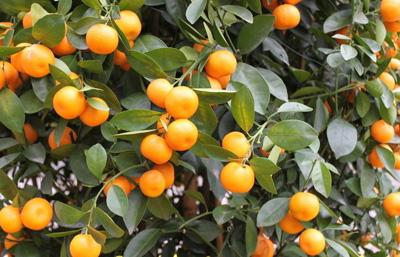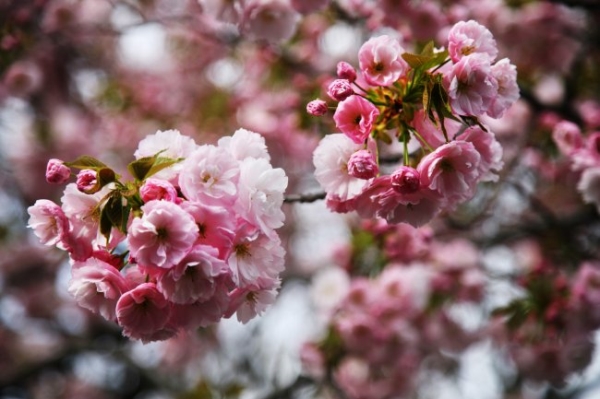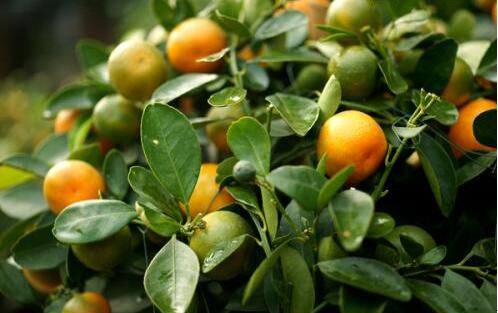The reason for the yellowing of the leaves of golden orange trees
The first reason-physiological defoliation
If there are no mistakes in the process of breeding kumquat trees, then the yellow leaves of kumquat trees are the natural condition of growth. Don't worry too much about this situation, and new leaves will grow in the future.
The second reason-improper watering
Kumquat trees are not resistant to moisture, so if watered improperly, it is easy to cause kumquat trees to wither, which causes the yellow leaves of kumquat trees.
The third reason-temperature management
Kumquat trees like high temperature environment, so once the temperature is too low, it will lead to kumquat leaves yellow and other problems.
The fourth reason-improper fertilization
If too much fertilizer is applied to kumquat trees, it will cause kumquat leaves to turn yellow, or fertilizer is accidentally sprinkled on the leaves, burning the leaves and causing them to turn yellow.

These are the reasons why kumquat leaves yellow, the next small series will introduce you to the correct kumquat breeding method.
Home Feng Shui Plants: Kumquat's Feng Shui Role
Kumquat, also known as kumquat, belongs to rutaceae, is a famous fruit plant. During the holidays, for the sake of luck, many people will put a pot of kumquat trees in their homes. The golden fruits exude a fresh fragrance, which makes people relaxed and happy. So what is the role of kumquat trees in home feng shui? Let's find out.
Kumquat,"orange" homonym for good luck,"gold" for money, kumquat also therefore has the meaning of auspicious fortune. The general family buys kumquat tree, mainly in the living room, to discuss the mouth color "auspicious","icing on the cake" and so on, is a very good auspicious prosperous way.
To choose kumquat as a household feng shui plant, there is attention, can not be too arbitrary. From the point of view of geomancy, kumquat tree shape, tree shape, leaf color, and even the number and size of oranges may directly affect the luck of the new year, so be careful.
1. Oranges are all fruit fat. When purchasing kumquat trees, we should choose kumquat trees with uniform fruit growth and distribution, which look round and full, and rich fruits, instead of buying kumquat trees with sparse fruit growth, Liao Liao, uneven distribution and sparse gaps. Cause and effect sparse have "more bad luck small" meaning, if the purchase of such kumquat tree, then hidden "bad luck" ominous omen, the new year's family luck is extremely unfavorable.
2. Green leaves, lucky Lu. Kumquat leaves grow green, there is a vibrant atmosphere, indicating that individuals or families as a whole in the new year's luck is particularly good, not only good fortune, good business, good popularity. And if the kumquat leaves are yellow and look sick, then the luck is not necessarily good. The ancient Book of Changes said,"Heaven hangs like a sign, seeing good or bad" is this truth.
Third, the trunk straight, hundred things. Kumquat tree shape, can reflect a person's luck. Kumquat trees grow luxuriant foliage, fruitful, beautiful tree shape, indicating that the business in the coming year is prosperous, the financial resources are abundant, all seek easy success, and all wishes come true; and if the tree shape grows crooked and crooked, it looks more like an old dish, indicating bad luck, more frustration, half the effort, and nine empty. So when choosing kumquat trees, it is important to choose upright trees.
Fourth, orange big, rise quickly. When buying kumquat trees, it is advisable to choose those fruits that grow larger, yellow or red and shiny. The orange is red for the United States, kumquat and golden eggs are golden yellow for the best.
Conclusion: Feng Shui believes that the living room is a very important place, generally speaking, the financial position of the living room can not be pressed, it is best to put perennial green ornamental plants, will enhance wealth, and kumquat beautiful appearance, can play a decorative role, but also prosperous luck, is an ideal choice for home feng shui plants.
Kumquat tree bonsai grafting maintenance method Kumquat tree bonsai grafting maintenance method introduction: generally through the branch grafting, in March-April with the cutting method; bud grafting in June-September; by grafting in June, potted commonly used this method. Grafting survived the second year before germination can be transplanted, to bring more soil. Potted kumquat, as long as it is moved indoors when it is cold, it can generally survive the winter safely. The room temperature should not be too high. Too high will lead to growth decline. Every 1-2 years, the soil is changed when it comes out of the room in spring, and after the soil is changed, it is maintained in the shade for half a month, and then it is cultivated in the sun. Kumquat should be pruned reasonably, in February-March, cutting off dense branches, thin branches, cross overlapping branches, drooping branches and dead branches. Strong branches do not have to cut, excessive long branches should head, senescent branches cut short, promote it to renew. After pruning, it is necessary to make the branches not disordered, but also to maintain a considerable density, forming a good round-headed crown. July autumn shoots new, too dense and affect the tree branches should be removed in time. Water and fertilizer management should be appropriate, such as yellow leaves, may be too wet, immediately "buckle water"; such as dry leaves roll, should immediately supplement water. In order to achieve the purpose of fruit observation, phosphorus fertilizer should be appropriately applied. During the maintenance process, attention should also be paid to the sunward nature. If the flowerpot faces south, it still needs to face south after moving. The light cannot be disturbed, otherwise the tree will not flourish. Kumquat trees are elegant, fragrant and exquisite. They are planted under courtyard windows or clustered around lawn bushes, adding color to the depressed winter. It is resistant to carbon dioxide and can also be used as a plant greening tree. Kumquat fruit, flowers into medicine, can qi depression, stasis, sober up. Root into medicine, there are qi, phlegm, Sanjie function. The maintenance method of kumquat bonsai 1. Water system promotes the growth of spring shoots for about a month. When the branches have not yet lignified, the water system of potted kumquat is drought treatment. It is advisable to roll the leaves but not yet roll them to the midvein. If they are severely curled, they will produce deciduous phenomena. After that, from 11:00 to 17:00 every day, spray water on the leaves for 3~4 times to make the leaves wet and open and then lose water and curl. After one week, observe the axillary buds of the branches. If the axillary buds expand and become light green round-headed protrusions, it means that they have become flower buds. The treatment of water control and flower promotion can be finished. After that, normal fertilizer and water management can be carried out. After a few days, the leaves develop normally, and the axillary buds quickly sprout into flowers. 2. Pruning technique In early March, the potted kumquat was pruned again, and all fruits were cut off, only 4~5 main branches were reserved, and the core was picked once when 10 leaves sprouted to promote the germination of new branches. All branches that grow in summer can become fruit branches, and branches that grow in autumn should be cut off. After fruiting, the newly sprouted branches should also be removed to avoid competing with the fruit for nutrients. Generally, a branch retains 2 to 3 fruits, and it is necessary to properly thin flowers and fruits to promote uniform fruit size. 3. The time of ring cutting to promote rosette cutting depends on the growth potential of kumquat. In summer, the sprouting branches grow for about 25 days. Generally, one circle is cut. After cutting, the water is controlled to not roll the leaves. After half a month, the leaves turn yellow, and flower buds will form after 20 days. Ring cutting is only suitable for strong branches of strong trees, not for weak branches of weak trees. 4. Spraying GA3 20mg/L or 2.4-D10mg/L+0.3% urea after flower thinning was beneficial to fruit setting. Spraying 0.3% potassium dihydrogen phosphate and 40mg/L anti-falling element at young fruit stage is beneficial to young fruit development. 0.3% urea +2.4mg/L-D20mg/L.5. Fertilizer and water management. Irrigation once every 2~3 days in spring and autumn, irrigation once a day in sunny summer. Before germination, nitrogen-based compound fertilizer was applied. Apply nitrogen and potash fertilizer after fruiting, but not too much nitrogen. After the result, do not irrigate when basin soil is not dry, irrigate is irrigate thoroughly for principle, irrigate the alum fertilizer water containing phosphor, calcic or the cake fertilizer that retting makes. Summer shoot growth period, if the pot soil moisture is too large, will cause flower drop fruit. Basin soil should not be too dry, fruit hanging period, too much water, will also drop fruit. The main diseases and insect pests of kumquat are canker disease, scab disease, yellow butterfly, jade belt butterfly, red spider, leaf miner, rust tick, orange aphid, star beetle, etc., which should be controlled in time.
- Prev

How many years does it take for cherry trees to bloom?
If you buy cherry saplings at a market or nursery, they usually bloom within the year they are planted. If it is their own grafting propagation seedlings, the next year will bloom, and cherry tree growth speed for the medium speed, remember not to overshoot, to wait patiently for its flowering oh. so
- Next

Why did the kumquat tree lose its leaves?
The first reason-lack of nutrients. If kumquat is given too little nitrogen fertilizer, kumquat trees will lose their leaves. Or after it enters the dormant period, it fertilizes so much that it burns the roots and begins to lose leaves. The second reason-- when watering kumquat improperly, the root of kumquat was overwatered and rotted.
Related
- Fuxing push coffee new agricultural production and marketing class: lack of small-scale processing plants
- Jujube rice field leisure farm deep ploughing Yilan for five years to create a space for organic food and play
- Nongyu Farm-A trial of organic papaya for brave women with advanced technology
- Four points for attention in the prevention and control of diseases and insect pests of edible fungi
- How to add nutrient solution to Edible Fungi
- Is there any good way to control edible fungus mites?
- Open Inoculation Technology of Edible Fungi
- Is there any clever way to use fertilizer for edible fungus in winter?
- What agents are used to kill the pathogens of edible fungi in the mushroom shed?
- Rapid drying of Edible Fungi

